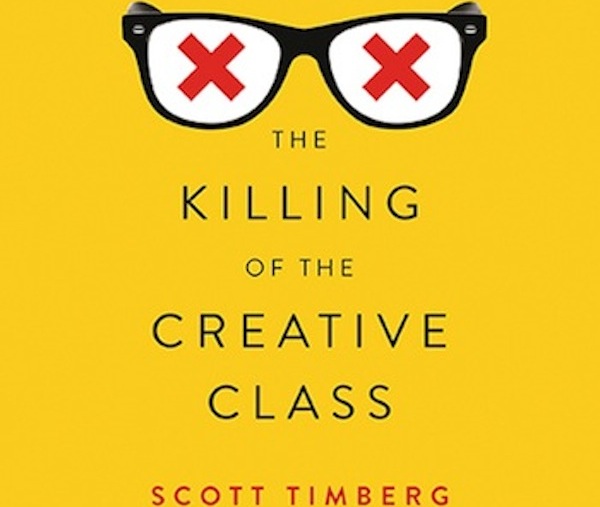Book Review: “Culture Crash” — The People Who Followed Their Bliss Off a Cliff
Truth is, the fraying of the middle class is not just something that has happened to creatives.
Culture Crash: The Killing of the Creative Class by Scott Timberg. Yale University Press, 320 pages, $26.

By Debra Cash
This past September, The New Yorker published a cartoon that made me groan aloud.
In Pat Byrnes’ deft drawing, a homeless guy — baseball cap above an unshaven face, shirt hem untucked under his hoodie and loose jacket, is begging. The sign he is holding says “FOLLOWED MY BLISS.” Scott Timberg has spent a lot of time dismayed about what has happened to the American creative professionals who followed their bliss off a cliff. The former Los Angeles Times arts reporter opens his new book Culture Crash: The Killing of the Creative Class by describing what he felt like when his wife told him that the bank was foreclosing on his house.
Over the past two decades, there have been two interlocking narratives about how “the creative class” would thrive in the new century. In one, popularized primarily by Richard Florida, creative professionals and “knowledge workers” are the engine of an affluent urbanism, bringing enhanced quality of life and the cachet of hipness to cities that have to compete for new blood. Its avatar is the designer in the black tee-shirt, disrupting conventional market forces as he — and it’s usually he — expresses innovation and gets rich doing so, maybe even inventing a new industry along the way.
The second narrative is Wired editor Chris Anderson’s theory of “the long tail.” Mass markets might have been destroyed by the advent of the internet, but creative people, even those whose work would be otherwise seen as niche or fringey, will be able to aggregate their audiences frictionlessly across time zones. For a while, at least, the heroine of this narrative was singer Amanda Palmer of the Dresden Dolls, whose fans were willing to put over $1 million into her Kickstarter campaign.
Timberg is here to tell us that these narratives are not true, or if they are, their truth applies to a tiny cohort. It’s not true for members of the creative class in the admittedly high risk areas of writing, painting, film making, and the performing arts. It’s not true for the people whose dreams were intended to be more realistic, who ensconced themselves in the adjacent but still commercially respectable fields of architecture, graphic design, photography, publishing, journalism, and college teaching in the humanities. It turned out to not be true for people with jobs in the distribution network that kept the creative professionals in business, either, the book store, music store or video store clerks, with their of-the-moment curation; the deejays unearthing unplayed gems and sparking careers at independent radio stations; the publishing house editors polishing inspired manuscripts so that they could reach their readers. (You can read Bill Marx’s interview with Timberg here for his take on what happened to the people who had been keeping busy in the arts world.)
I don’t have to tell anyone reading The Arts Fuse that in the United States those expectations of solid middle class lives built on participation in “the creative class” have pretty much evaporated. I’ve been on the front lines of the collapse, and there’s nothing romantic or ennobling about it.
Back in 2011, I read an early Timberg salvo on this topic entitled “The Creative Class is a Lie.” That essay spurred a number of conversations among people who had been either blaming the 2008 recession, and hoping to ride it out, or who secretly thought they must be doing something wrong that could perhaps be fixed with a more aggressive social media strategy.

Author Scott Timberg: “If we’re not careful, culture work will become a luxury, like a vacation home.” Photo: Steven Dewall.
In Culture Crash he expands his argument. Like much of the newspaper journalism he and so many of his colleagues have had to leave behind, his narrative is strong on compelling anecdotes and bolstered with famous names (he particularly likes the odd couple of late urbanist philosopher Jane Jacobs and Talking Heads musician David Byrne) and occasionally startling, if dispiriting, statistics. But Culture Crash is not scholarship — he admits as much — and Timberg’s cri de coeur reflects a type of analysis that doesn’t connect all of the salient dots, and ultimately is not going to get most of us anywhere.
Timberg grew up in family of creative professionals. He says that he always saw himself “in the third generation of people who had worked in culture without either striking it rich or going broke.” His grandfather was a vaudeville pianist and wrote songs for cartoons, his grandmother danced for Zeigfield, and his dad was a political journalist. Other members of his extended family were teachers and graphic artists. I want to know more about what messages about making a living he learned from them and how their assumptions and successful strategies may have blinded him to other more current alternatives, but it’s worth noting at the start that Timberg wasn’t being a “creative” as a form of rebellious self-definition. He was an apple staying pretty close to the family tree.
Culture Crash begins its survey with a tale of three cities: Boston, Los Angeles and Austin. He doesn’t do so for geographic parity. Instead, he uses each example to show how a coterie of artists relied on existing civic structures and networks and built their own gathering places to create a resilient culture where they could compete, find appreciation in one another, and thrive. The Boston example centers around poetry in the late 1950s and 1960s, and its interconnection and dependence on the university system, The Poet’s Theatre, and publications. It was, he says, a time when “a life of genteel poverty was still possible.” LA is described not for its film stars but for its 1960s painters and gallerists. Austin in the 1970s is described for a fringe music scene that created its own standards and definition of success. It’s a reasonable list, but it leaves out a lot of other (and less homogeneously white) examples, including the Harlem Renaissance and/or Black Arts movement that had a far less accomodationist stance and might offer competing lessons.
He sketches the scenes, but mixes up his categories. No one in 1950s America, not even Robert Lowell, was ever expecting to get rich writing poetry. (Sylvia Plath, who kept thinking that if she was a real writer she would succeed contributing to slick women’s magazines, would have been gratified and amazed by her posthumous royalties.) Painters like Ed Ruscha and David Hockney, on the other hand, had no guarantees but worked in a discipline that always had real earnings potential, even if, as Timberg notes later in the book, the really big numbers come in with the secondary market, and a painting’s appreciated value typically isn’t shared with the artist. Austin may have thumbed its nose at “Nashville’s song factories” but when Willie Nelson got there he had already written “Crazy” and signed a $10,000/year contract with RCA Victor. Not everyone in Austin intended to remain an outlaw.
The structural conditions for each of these art forms were very different, and they have stayed different to the present day. To say that some cultures are blandly commercial while others value experimentation and exploration is certainly true — who can doubt it? — but there is commercial work that is bad, commercial work that is mediocre, and commercial work, like, for instance, Patsy Kline singing “Crazy” or David Hockney’s paintings, that can be splendid on its own terms. Some artists take a vow of poverty until they don’t have to, and some stay poor. Some were never really in the running because not everyone is equally gifted. But it’s ridiculous to say that cultural professionals deserve not to lose their houses and at the same time complain that the marketplace always bets on the least deserving horse.
Culture Crash points an angry finger at the internet. His prime example is the hollowing out of the music business, especially for indie rock. A lot of thorough analysis has been done in this area, and Timberg has availed himself of The Future of Music Coalition and the work of other concerned journalists. (There’s a good bibliography in his notes.) The music recording business has lost two thirds of its value in just over a decade, from $14.6 billion in revenues in 1999 to $5.35 billion in 2012. He notes that now, musicians earn on average 6 percent of their annual income from recordings.
He does not, however, go back to the devil’s deal that musicians made with recording labels early in the history of the industry, in which the money from record sales went to the studios and they were expected to make their living touring. Indie self-promotion turns out not to be any better.

Cellist Zoë Keating — the artist did everything right — in terms of social media — and still couldn’t generate much income. Photo: David Schless.
But for anyone who still believes in the redeeming monetization of social media contacts Timberg relates the sad anecdote of cellist Zoe Keating, who followed every rule of the new music economy. Keating self-releases her music, has 1.2 million Twitter followers, and in 2013, between two million YouTube views and 400,000 Spotify streams earned a combined total of about $3,000 from both services. That’s before adding in the problems of unpaid or pirated downloads.
Are these simply the unintended consequence of technological progress? Or are they acts of policy? Timberg shies away from a structural economic analysis. He’s rightfully angry that Gannett newspapers laid off 20,000 workers, lost 700 percent in its stock price but still managed to come up with a $37 million golden parachute for departing CEO Craig Dubow. He describes with horror how David Lowery of Camper Beethoven/Cracker moved the bands pages to Facebook, which then told the band “if you want your fans to see what you write, you have to pay us.” I’m angry and horrified too. But this brutal “winner take all” ethic follows an explicit neoliberal business model, with the various regulatory and tax policies in place that make these corporate behaviors possible and for some industries very desirable indeed.
Why hasn’t the fate of creative professionals gotten the attention Timberg thinks we deserve? He thinks it’s a residue of either the romantic expectation that artists are misunderstood geniuses who do their best work from garrets or pervasive anti-intellectualism, “part of a larger revolt against experts and expertise.” He even brings in reference to the Puritans. But much more likely, it’s the fact that the remaining media organizations and the digital platforms that are the distribution channels for cultural work are the ones whose bread is being buttered. The people at the tops of those distribution channels are doing great.
“If we’re not careful, culture work will become a luxury, like a vacation home,” Timberg writes. It’s a good line, and one that anyone who values a diverse cultural ecology would want to affirm. What he doesn’t want to admit is that, absent direct patronage, professional culture workers have often depended on outside sources of income. For some it was the second job (in the post-war period, that job was primarily teaching, a job indirectly subsidized by the government in the form of the G.I. Bill fostering a new population of students). For others, it was something unrelated (meet pediatrician William Carlos Williams). For many (more than we have usually acknowledged and certainly more than today’s BFA and MFA students are aware) it was a trust fund, family member, or a spouse of means. That cushion made it possible for a talented person work on a novel or a painting until the work could earn respect, if not a proportionate wage for the work the artist put into it. Maybe the market would respond, and maybe it wouldn’t, but at least the creative person had a chance to find out.
That’s one of the reasons that pop culture exhortations to follow one’s bliss are so maddening. They imply a kind of privilege at the very heart of the class structures Americans are eager to say don’t exist. The fraying of the middle class is not just something that has happened to creatives. It’s just that Timberg never thought that what had happened to unionized manufacturing workers could happen to the educated type of knowledge workers who worked at the LA Times.
Debra Cash has reported, taught and lectured on dance, performing arts, design and cultural policy for print, broadcast and internet media. She regularly presents pre-concert talks, writes program notes and moderates events sponsored by World Music/CRASHarts and cultural venues throughout New England. A former Boston Globe and WBUR dance critic, she is a two-time winner of the Creative Arts Award for poetry from the Hadassah-Brandeis Institute and will return to the 2015 Bates Dance Festival as Scholar in Residence.
c 2015 Debra Cash
Tagged: Culture Clash: The Killing of the Creative Class

Love the review. Your arguments are measured and well stated. Having managed a creative career in a number of arts, I feel lucky as much as anything. It’s a wonderful endless conversation because so many parts are true – technological progress, policy, anti-intellectualism, commercialism, class. And I see the patronage of families, particularly for white middle class artists is often not acknowledged. Must read!
Latest in the story: Zoe Keating, the cellist mentioned in Timberg’s book, is being strong-armed by Youtube: the independent artist ends up being pressured by corporate interests even when she tries to be a DIY entrepreneur. A cautionary story worth reading about.
http://zoekeating.tumblr.com/post/108898194009/what-should-i-do-about-youtube?curator=MediaREDEF